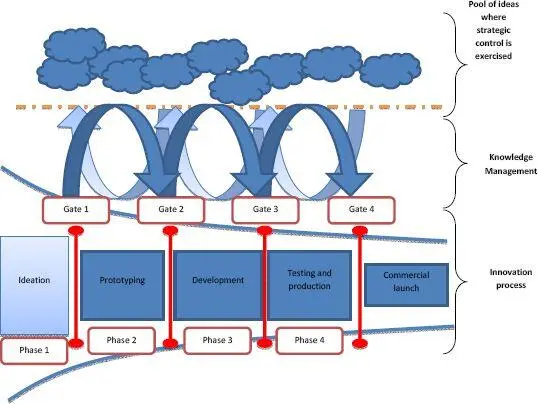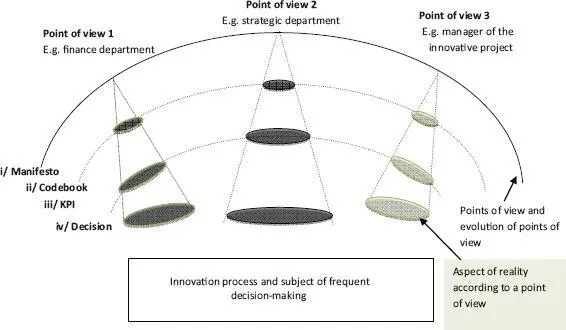
Figure 2.1. An innovation process (source: Cohendet and Simon 2015). For a color version of this figure, see www.iste.co.uk/uzunidis/innovation1.zip
The first step is the ideation. Innovation management is interested in techniques to generate a large number and variety of ideas (Agogué 2016). During this stage, the selection of ideas is not final; the least promising ones are not entirely discarded. In this representation, non-validated ideas are put into organizational memory for later use. It is a “stock” with special characteristics.
David (2018) shows that each step of the process requires knowledge management based on human interaction or relying on an information system. The main challenge of knowledge management is the pooling of knowledge from the different phases of the stage-gate and its reuse in other projects, leading to its improvement or the creation of new knowledge (Hussler and Burger-Helmchen 2019). A fundamental element of the process is the “pool” or repertoire of ideas. This pool of ideas not only contains possibilities to be explored, but above all contributes to the selection process. This creative pool, whose characteristics are shaped by the culture and history of the company, has strategic implications throughout the innovation process. Thus, creativity – non operationalized – will not disappear during the other phases of the process: it feeds the pool of ideas, shapes and co-creates the decision-making process for future decisions.
2.3.2. Managing innovation means managing the time for decisions
It is recognized that the different actors involved in this process have different views on opportunities and on what ideas are worth developing (Boisot and Macmillan 2004). In order to make sense of innovation processes, researchers and practitioners work to use representations of reality. These simplifications are not the same in all organizations. They depend on the culture of the organization and the knowledge and skills of the person designing the model. Depending on the knowledge of each manager, the model will focus on certain types of elements. Finance managers will focus on costs, financial risks and other key performance indicators (KPIs). Figure 26.2 emphasizes that each decision-maker has a manifesto (a theoretical representation that corresponds to their own values and worldview). These worldviews are implemented in codebooks that are functional, sectoral or hierarchical. Each activity will have a specific set of key performance indicators (KPIs), ultimately leading to a decision at the end of the process. Such an approach, originally designed for business models, can easily translate into process innovations that can rationally explain why different people within a company have radically different views on innovations and ideas.
These decisions are sometimes imposed by the market or by the internal rules of the organization, and at other times are left without clearly established limits. In all these circumstances, the objective of the decisions is to improve the position of the company, to produce innovation, and also to capture value, to appropriate it.

Figure 2.2. The meeting of viewpoints during the innovation process (source: Bollinger 2020). For a color version of this figure, see www.iste.co.uk/uzunidis/innovation1.zip
2.4. Managing innovation: a question of matter
Once the idea has been developed, improved and transformed, in a particular time and space, into an innovation (product, service, organizational, business model, etc.), the question of its appropriation arises. Appropriation can be understood as “the action of adapting something to a given use”, and also as “appropriating something, making it one’s own”. More graphically, it is also “the natural action by which food enters the body” ( https://www.cnrtl.fr). In the case of innovation management, this leads us, on one hand, to question what it means to adapt an innovation and make it one’s own, and, on the other, to understand the modalities for implementing such an action. We propose to answer these questions according to the type of “organism”, or actor in the organization. We have chosen three emblematic ones: (1) consumers, (2) members of the organization and (3) shareholders.
2.4.1. The appropriation of innovation by consumers
According to Schumpeter, innovation is the first commercial transaction of an invention. In other words, a customer is willing to invest resources in the invention. Essentially, this means that this client identifies the value of this invention in relation to a use that is specific to them. Then, the organization has to propose an attractive value for the client. Up until the mid-2000s, the consumer remained “at the end of the chain”; this meant that this value had to be anticipated and identified at the beginning of the innovation process, with a high risk of going wrong. Since then, the consumer’s position has evolved, and they are now involved in the co-creation of the product, participating in its promotion and dissemination (Cova and Cova 2009). In this sense, marketing research emphasizes how essential it is to integrate the consumer from the beginning of the process, which facilitates the identification and proposal of a particular value.
This is referred to as “consumer empowerment” (Fayn et al . 2019). This “delegation of power to the consumer” can be initiated by the organization itself in a “top-down” movement. In this case, it leaves the consumer free to choose certain technical or aesthetic characteristics, it includes them in the creation of the product, in its promotion and distribution (Cova and Cova 2009; Piligrimiene et al . 2015). The consumer is in a partnership relationship with the company. By contrast, this delegation of power can be more of a “power grab” by the consumer, who, for example, via comments on social networks, can direct consumption. It is more of a liberation according to a “bottom-up” movement, which can express an assertion of counter-power on the part of consumers in the face of traditional consumption, or even a civic commitment to more sustainable and democratic structures (Papaoikonomou and Alarcón 2015).
According to the two movements mentioned, consumer empowerment does not imply exactly the same notions in marketing (Fayn et al . 2019), which consequently influences work in innovation management. In the case of the “top-down” movement, it is a question of relational marketing (establishment of lasting relationships with the consumer) or marketing knowledge (mobilization and development of customer skills), whereas in the case of the “bottom-up” movement, it is more the notions of consumerism (or consumer resistance) or engagement (involvement of the customer beyond the transaction). However, the notion of brand community (a group of customers attached to the same brand values) is present in both, knowing that the “bottom-up” movement is favored by information and communication technologies, and, more broadly, by digital technology. Indeed, social media, evaluation platforms and online petitions reinforce the power of the consumer in the face of the organization (Fleck and Ambroise 2019). Ignoring this becomes impossible and, above all, a strategic error with serious consequences.
Читать дальше














